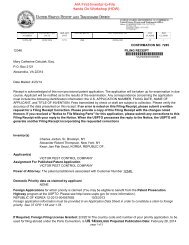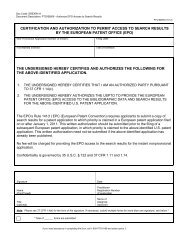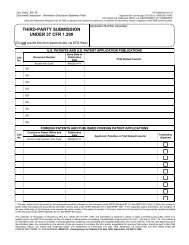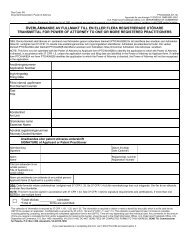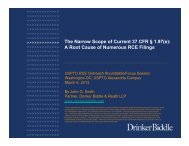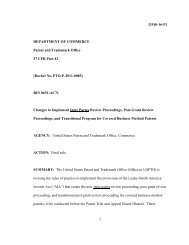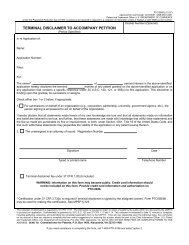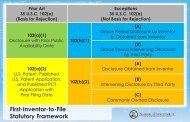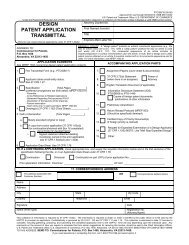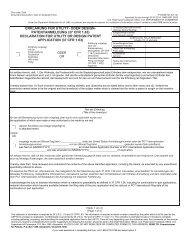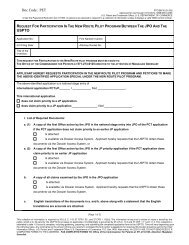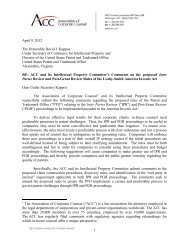USPTO Performance and Accountability Report - U.S. Patent and ...
USPTO Performance and Accountability Report - U.S. Patent and ...
USPTO Performance and Accountability Report - U.S. Patent and ...
You also want an ePaper? Increase the reach of your titles
YUMPU automatically turns print PDFs into web optimized ePapers that Google loves.
18<br />
MANAGEMENT’S DISCUSSION AND ANALYSIS<br />
OBJECTIVE 1: Re-engineer patent process<br />
to increase efficiencies <strong>and</strong> strengthen<br />
effectiveness<br />
The <strong>USPTO</strong> is realizing benefits from the success of<br />
various initiatives, pilots, <strong>and</strong> operational improvements.<br />
The agency is moving from a one-track<br />
patent examination process to a multi-track process<br />
by adopting procedures <strong>and</strong> initiatives that incentivize<br />
ab<strong>and</strong>oning applications that are not<br />
important to applicants; accelerating critical technologies;<br />
permitting an applicant to accelerate<br />
applications; <strong>and</strong> exploring other incentive <strong>and</strong><br />
accelerated examination options. Specific initiatives<br />
include:<br />
Track One<br />
The <strong>USPTO</strong> launched the AIA-m<strong>and</strong>ated accelerated<br />
examination program (Track One) that allows<br />
patent applications to be processed to completion<br />
in 12 months <strong>and</strong> offers small businesses a discount<br />
on this option. Since its inception, the agency<br />
received more than 6,000 Track One patent applications,<br />
<strong>and</strong> more than 2,400 entrepreneurs have<br />
taken advantage of those 50 percent discounts.<br />
The agency completed more than 3,900 first actions<br />
on Track One examinations in an average of 50 days,<br />
mailed over 1,085 allowances, <strong>and</strong> issued more<br />
than 677 patents.<br />
First Action Interview Pilot Program<br />
The First Action Interview Pilot Program allows participants<br />
to conduct an interview with the examiner as<br />
soon as the prior art search has been conducted.<br />
This program was exp<strong>and</strong>ed from a small pilot program<br />
to include additional technical areas, enhance efficiency,<br />
<strong>and</strong> provide more options to participants.<br />
The program has many benefits including: (1) the<br />
ability to advance prosecution of an application;<br />
(2) enhanced interaction between the applicant <strong>and</strong><br />
the examiner; (3) the opportunity to resolve patentability<br />
issues one-on-one with the examiner at the<br />
beginning of the prosecution process <strong>and</strong>; (4) the<br />
opportunity to facilitate early allowance. The First-Action<br />
Interview Pilot Program notice was originally signed<br />
March 24, 2008. The <strong>USPTO</strong> launched the Full First<br />
Action Interview Pilot Program on May 16, 2011.<br />
This program exp<strong>and</strong>s on the First Action Interview Pilot<br />
PERFORMANCE AND ACCOUNTABILITY REPORT: FISCAL YEAR 2012<br />
Program by including all utility applications in all technology<br />
areas <strong>and</strong> filing dates. As with the previous First<br />
Action Interview pilot programs, the applicant is<br />
entitled to a first action interview, upon request, prior<br />
to the first office action on the merits. This pilot has<br />
been extended to run through November 16, 2012.<br />
A total of 3,533 applicants have joined the programs<br />
since April 2008, 870 interviews have been conducted,<br />
<strong>and</strong> 1,304 of the applications have been allowed.<br />
The program has an overall first action allowance rate<br />
of 29.4 percent as compared with 11.5 percent for all<br />
original non-continuing applications in FY 2012.<br />
After Final Practice <strong>and</strong> Quick Path IDS (QPIDS)<br />
Pilots<br />
As another part of our ongoing efforts toward<br />
compact prosecution <strong>and</strong> increased collaboration<br />
between examiners <strong>and</strong> stakeholders, we recently<br />
announced the start of the After Final Consideration<br />
Pilot (AFCP) <strong>and</strong> QPIDS pilots. The AFCP allows additional<br />
flexibility for applicants <strong>and</strong> examiners to work<br />
together in “after final” situations to move applications<br />
toward allowance.<br />
Our QPIDS pilot provides consideration of an Information<br />
Disclosure Statement (IDS) submitted after the<br />
payment of the issue fee without requiring a Request<br />
for Continued Examination (RCE). The objective of<br />
this new pilot program is to reduce the number of<br />
RCEs filed for consideration of an IDS after the issue<br />
fee is paid.<br />
Table 3 below provides the relative cost effectiveness<br />
of the entire patent examination process over time,<br />
or the efficiency with which the organization applies<br />
its resources to production.<br />
TABLE 3 Measure: Total Cost Per<br />
<strong>Patent</strong> Production Unit<br />
FISCAL YEAR TARGET ACTUAL<br />
Target Met.<br />
2008 $3,982 $3,773<br />
2009 $3,562 $3,523<br />
2010 $3,530 $3,471<br />
2011 $4,041 $3,594<br />
2012 $3,970 $3,617<br />
2013 $4,041<br />
2014 $3,878


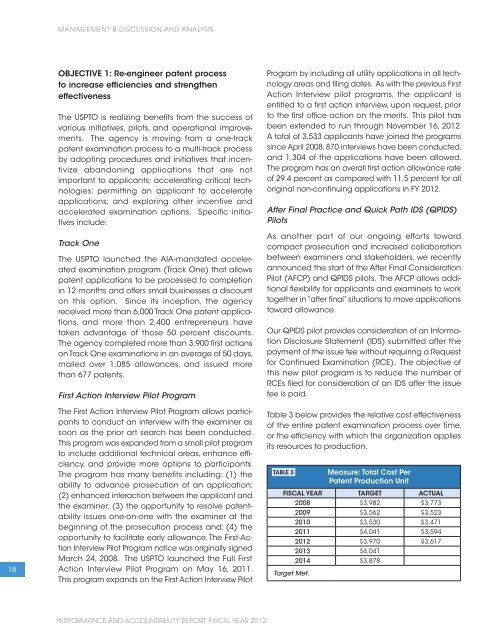
![Printable version [PDF] - United States Patent and Trademark Office](https://img.yumpu.com/51835259/1/184x260/printable-version-pdf-united-states-patent-and-trademark-office.jpg?quality=85)
